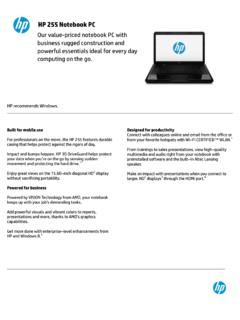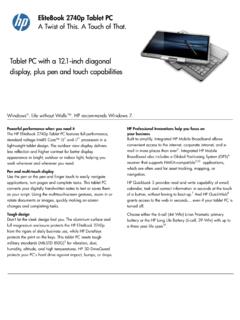Transcription of Displaying a custom logo during bootup of HP commercial ...
1 Technical white paper Displaying a custom logo during bootup of HP. commercial notebook systems HowTo Table of contents Introduction 2. Determining the BIOS generation 2. Utility 3. Image requirements 3. Command-line switches 3. Obtaining and preparing the EFI shell 3. Instructions for running from the EFI shell 4. Utility 6. Image requirements 7. Command-line switches 7. Command-line examples 7. Adding a custom logo to the HP_Tools partition 8. Priority order of the BIOS-replaced image and the custom logo in the HP_Tools partition 8. Systems running BIOS 08 8. Systems running BIOS 09, BIOS 2011, or BIOS 2012 9. Call to action 10. Introduction HP provides several methods that customers can use to replace the HP logo with their own logo on the splash screen that appears during system POST. The HP utility, available for commercial notebooks running BIOS 2012 generations The HP utility, available for commercial notebooks running BIOS 08, BIOS 09, or BIOS 2011.
2 Generations The HP_Tools partition This document briefly describes all three methods and how to use them. It also explains the priority order of the logo images if you have a custom logo in the HP_Tools partition and you've also altered the logo in the BIOS. This document is written for the IT manager or implementer responsible for changing the logo. Determining the BIOS generation Table 1 gives the BIOS generations available as of this writing for HP commercial notebook systems. The tool and image type you can use depends on the BIOS generation on your system. Table 1: The BIOS generation, tool, and image type supported for HP commercial notebook systems as of June 2012. BIOS Image type Models Tool generation supported BIOS 2012 HP EliteBook 9470m, HP ProBook 4545s, HP ProBook 4445s, .jpg HP ProBook 4446s, HP ProBook 4340s, HP ProBook 4341s, HP ProBook 4440s, HP ProBook 4441s, HP ProBook 4540s, HP ProBook 4740s, HP ProBook 6475b, HP EliteBook 8470w, HP EliteBook 8470p, HP ProBook 6470b, HP EliteBook 8570p, HP ProBook 6570b, HP EliteBook 2170p, HP EliteBook 8570w, HP EliteBook 8770w, HP EliteBook 2570p BIOS 2011 HP EliteBook 8560w, HP ProBook 4230s, HP ProBook 4330s.
3 Jpg HP ProBook 4430s, HP ProBook 4530s, HP ProBook 4730s, HP EliteBook 8760w, HP EliteBook 2560p, HP ProBook 4435s, HP ProBook 4436s, HP ProBook 4535s, HP ProBook 6465b, HP ProBook 6565b, HP EliteBook 8460p, HP EliteBook 8460w, HP ProBook 6460b, HP EliteBook 8560p, HP ProBook 6560b, HP ProBook 6360b, HP ProBook 5330m, HP EliteBook 2760p BIOS 09 HP Elitebook 8440 p/w, HP Elitebook 8540 p/w, .jpg HP Elitebook 2540p, HP ProBook 6440b, HP ProBook 6540b, HP ProBook 5320m, HP ProBook 6450b, HP ProBook 6550b, HP Elitebook 8740w, HP Mini 5103, HP Mini 5102, HP ProBook 6455b, HP ProBook 6555b, compaq 325, compaq 326, HP 425, HP 625, HP ProBook 5220m, HP ProBook 4320s, HP ProBook 4420s, HP ProBook 4321s, HP ProBook 4421s, HP ProBook 4325s, HP ProBook 4326s, HP ProBook 4425s, HP Elitebook2740p, HP ProBook 4520s, HP ProBook 4720s, HP ProBook 4525s BIOS 08 HP compaq 6730s, HP compaq 6731s, HP compaq 6530s.
4 Bmp HP compaq 6531s, HP compaq 6830s, HP compaq 6735s, HP compaq 6535s, HP compaq 2230s, HP compaq 6530b , HP compaq 6730b, HP compaq 6735b, HP compaq 6535b, HP EliteBook 6930p, HP EliteBook 8530 p/w, HP EliteBook 8730w, HP EliteBook 2530p, HP EliteBook 2730p 2. Utility For the BIOS 2012 generation, run the utility from an EFI shell. The .EFI utility puts your custom logo image into the system BIOS. You cannot use this utility if a BIOS password has been set. Image requirements The image must meet the following requirements: .jpg file format Resolution range between 424 x 320 pixels and 1024 x 768 pixels File size maximum of 32 kilobytes Maximum of 16 million colors Command-line switches You can use the utility to write a custom logo to the BIOS or to erase a custom logo that has already been added. To write a custom logo to the BIOS, use the following syntax: ereplogo <filename>.
5 To erase a custom logo from the BIOS and return the default HP logo to the display, use: ereplogo /e To display a usage statement similar to the following, type: ereplogo /h EFI custom Logo Update Utility for HP Business Notebook Platforms Version: 09/16/2011. To update logo: eRepLogo filename To erase logo: eRepLogo /e Obtaining and preparing the EFI shell The EFI shell is included in the same SoftPaq that contains the utility. Copy the EFI shell, the utility, and your custom logo image to a FAT32-formatted USB key. To determine whether your USB key is FAT32: 1. Insert the key into an available USB port, and then open Windows Explorer. 2. Right-click the highlighted listing for the USB key drive, and select Properties. 3. The General Properties window opens, showing whether the USB key uses an NTFS or a FAT32 file system. To format the USB key as FAT32: 1. Insert the key into an available USB port, and then open Windows Explorer.
6 2. Right-click the highlighted listing for the USB key, and select Format. 3. The Format window opens (Figure 1). Use the drop-down menu to select FAT32 (not FAT) as the file system. 3. Figure 1: The FAT32 file system option Instructions for running from the EFI shell 1. Boot the system, and then press the f10 key at POST to enter BIOS Setup. 2. Open the System Configuration menu, and then select Boot Options. Under Boot Mode, select UEFI Native mode. 3. Open the File menu, and then choose Save and Exit. 4. Insert the USB key containing the required files, and then reboot the system. 5. Press the f9 key (Boot device options) at POST to launch the boot manager. 6. Choose Boot from EFI File as shown in Figure 2. Figure 2: The Boot from EFI File option 4. 7. Select the USB Key from the list, as shown in the example in Figure 3. Figure 3: The USB key option 8. From the EFI File Navigator, search for and select the option, as shown in Figure 4.
7 Figure 4: file within the ereplogo_files folder 9. The EFI shell launches and displays a command prompt of Shell>. 10. Change to the USB key location by typing the drive associated with the key (for example, FS1:), and then press Enter. 11. Go to the location of the utility using the cd command, as shown in Figure 5. 5. Figure 5: Steps 9, 10, and 11. 12. Refer to syntax to start using the tool. You can use the tool to write or erase a custom logo, as already discussed in the Command-line switches section. The tool will reboot the system after writing the logo. 13. Reboot the system (if the system does not reboot automatically after using the tool), and then press the f10 key at POST to enter BIOS Setup. 14. Open the System Configuration menu, and then select Boot Options. 15. Under Boot Mode, check Legacy mode to return to the system's original setting while running step 2. 16.
8 Save the changes and exit Setup. The custom logo will now display during POST. Utility Use the utility for HP commercial notebook systems running BIOS 08, BIOS 09, or BIOS 2011. Systems running BIOS 2012 cannot use the utility. You must run from a DOS environment. You cannot run from Windows. The most common way to boot into DOS is to load DOS onto a USB key or other bootable device. You can press the f9 key (Boot device options) at POST to launch the boot manager then choose your bootable device containing DOS. At the DOS command prompt, begin typing the command and its parameters (described in the Command-line switches section). You cannot use this utility if a BIOS password has been set. 6. Image requirements The image must meet the following requirements: .bmp file format for systems using BIOS 08..jpg file format for systems using BIOS 09 or BIOS 2011. Resolution range between 424 x 320 pixels and 1024 x 768 pixels File size maximum of 32 kilobytes Maximum of 16 million colors Command-line switches The utility accepts multiple input parameters, identified by a command line switch.
9 It uses the following syntax: [/<Option> <parameter>] as shown in Table 2. Table 2: Command-line syntax for the utility Command Valid values Description option /e None Erases current logo in Flash ROM. /fFilename ASCII Text Command to specify the .bmp or .jpg image file used as the logo displayed during POST. If you enter no parameters or enter invalid parameters, the utility displays a usage statement similar to the following: HPQ EFI BIOS Logo Replace - Version Copyright 2008 - Hewlett-Packard Corporation Usage: EREPLOGO [/e] /fFilename /e: Erase the current logo in the EFI BIOS. /fFilename: Bitmap or JPEG file created to be used as the logo Command-line examples The following examples were run on an HP Elitebook 2730p notebook with an HP logo. Using the /f option to replace the existing logo This example replaces the existing logo in the Flash ROM device with a new logo file.
10 C:\> EREPLOGO HPQ EFI BIOS Logo Replace - Version Copyright 2008 - Hewlett-Packard Corporation Logo File Size: 21878 bytes Flash Logo Programming Successful Done. Using the /e option to erase the logo in the Flash ROM. The following example shows how to use the erase /e option to erase an existing logo and return the display to the default HP logo. 7. C:\> EREPLOGO /e HPQ EFI BIOS Logo Replace - Version Copyright 2008 - Hewlett-Packard Corporation Logo erased from EFI BIOS. Done. Adding a custom logo to the HP_Tools partition Instead of using one of the EREPLOGO utilities to replace the default HP logo, you can also place your custom image in a specific location in the HP_Tools partition. 1. Select the custom logo image you want to use. For BIOS 09, BIOS 2011, and BIOS 2012, it must be in .jpg file format. For BIOS 08 it must be in .bmp file format. 2. In the Hewlett-Packard folder on the HP_TOOLS partition, create a folder called Logo.









